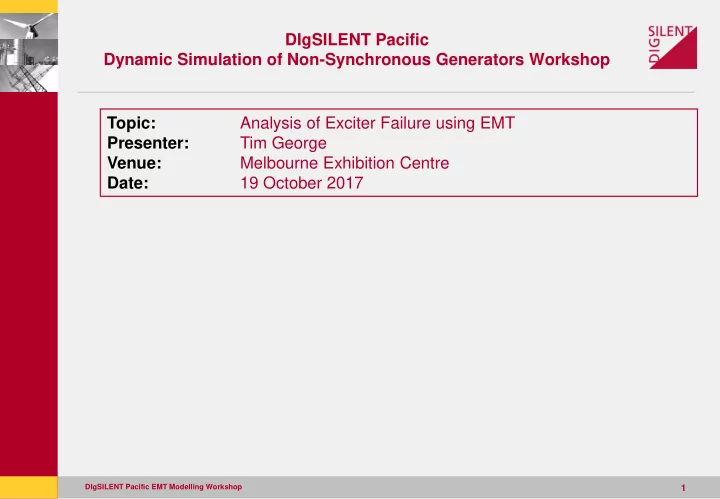

DIgSILENT Pacific Dynamic Simulation of Non-Synchronous Generators Workshop Topic: Analysis of Exciter Failure using EMT Presenter: Tim George Venue: Melbourne Exhibition Centre Date: 19 October 2017 DIgSILENT Pacific EMT Modelling Workshop 1
Agenda – war story 1. Overview of the plant and the event, what went wrong 2. Development of EMT model in PowerFactory 3. Benchmarking results 4. Analysis of potential waveforms in Exciter during event 5. Conclusions DIgSILENT Pacific EMT Modelling Workshop 2
Background • Analysis of a thermal generating unit >100MW • Excitation comprised of: • Dual channel analogue AVR • Analogue PSS • Brushless AC exciter • Asset owner refurbished the control system and upgraded to a new digital platform DIgSILENT Pacific EMT Modelling Workshop 3
Background - Schematics of excitation system • Brushless Excitation System • Diodes rotating on same shaft • Exciter is essentially a synchronous machine, but often ~ represented by a first order model = for simplicity SM E Rotating Source: ABB Switzerland DIgSILENT Pacific EMT Modelling Workshop 4
Typical rotating rectifier systems (Courtesy Electric Machinery Co) www.electricmachinery.com/_files/Brushless_Exciters/Series_Diode_Redundancy.pdf DIgSILENT Pacific EMT Modelling Workshop 5
Background - Event • Lengthy outage required to upgrade the control system and perform other works on the plant, including on maintenance on the Exciter • During commissioning of the new control system, a mechanical and electrical fault is observed that causes heat/fire in the AC exciter • Smoke was detected in the plant • The observed fault was detected during the return to service at Full Speed No Load, on the second energisation attempt of the new AVR DIgSILENT Pacific EMT Modelling Workshop 6
Comparison of first vs. second excitation during RTS Trip (pink waveform) Increased excitation DIgSILENT Pacific EMT Modelling Workshop 7
What went wrong? • Machine voltage did not exceed nominal. AVR set-point was intentionally reduced for first excitation of new system • Field response did not exceed ratings • Peak excitation current during second excitation is approximately >70% larger than the peak current during first excitation • Likely cause was a short circuit across one leg of the rotating rectifier • Further mechanical faults were observed during post-event investigations. Exciter machine covers opened for inspection and repairs DIgSILENT Pacific EMT Modelling Workshop 8
EMT model development • The next steps were to develop an EMT model to calculate potential fault current and waveform in the exciter • Consideration for the rotating diodes and co-ordination with fuses • Following elements considered: – Excitation transformer – Digital AVR control system – Six pulse thyristor – AC exciter modelled as a salient pole synchronous machine – Rotating diodes and fuses – Synchronous machine DIgSILENT Pacific EMT Modelling Workshop 9
Input data • Excitation transformer modelled with supply from 415V switchboard • Ideal voltage source used to represent switchboard with equivalent fault level • Digital AVR controller modelled using the provided transfer function from OEM in DSL • AVR six pulse thyristor represented by standard converter block in PowerFactory DIgSILENT Pacific EMT Modelling Workshop 10
Input data • AC exciter represented by a salient pole synchronous machine. Parameters estimated and fitted to curve • Each rotating diode and fuse modelled in PowerFactory DIgSILENT Pacific EMT Modelling Workshop 11
Assumptions • Field winding represented by a fixed source inductance • Parameters for the exciter synchronous machine model assumed and fitted • Commutation reactance of the exciter armature winding estimated based on historical datasheets DIgSILENT Pacific EMT Modelling Workshop 12
Benchmark of EMT model against historical data • Offline step response (integration time step of 0.1ms) DIgSILENT Pacific EMT Modelling Workshop 13
Fault scenario • Short circuit on one of the phases in rotating Exciter considered • Event simulated by a switch in parallel with a fuse and diode • Rectified output and each individual diode currents monitored during simulation to identify fault current and waveforms during event DIgSILENT Pacific EMT Modelling Workshop 14
Pre- and post-fault waveforms DIgSILENT Pacific EMT Modelling Workshop 15
DC current in healthy legs of exciter DIgSILENT Pacific EMT Modelling Workshop 16
Analysis • DC load current post-fault is similar to the pre-fault waveform, with the addition of a larger ripple • Fault current does not initially cause and of the fuses to operate • Highly unbalanced current waveforms that it is likely to cause excessive heating in the exciter in a short amount of time • Current is limited by the source inductance DIgSILENT Pacific EMT Modelling Workshop 17
Summary • Full EMT model developed and validated in PowerFactory of a brushless excitation system • Real fault scenario has been analysed which considers a short circuit across one diode and thus considering the risk of all other diodes and fuses • Using conservative assumptions, diodes and fuses are at risk of failure only after a pro-longed period of operation under the fault condition • Diode current waveforms in each leg are highly unbalanced with large peaks. This is likely to cause the observed excess heat in the exciter machine in a short amount of time during the faulted condition DIgSILENT Pacific EMT Modelling Workshop 18
QUESTIONS? DIgSILENT Pacific EMT Modelling Workshop 19
Recommend
More recommend